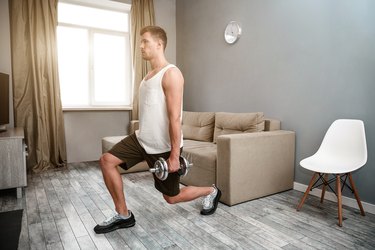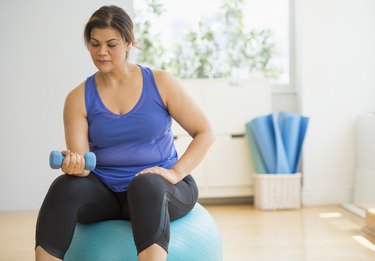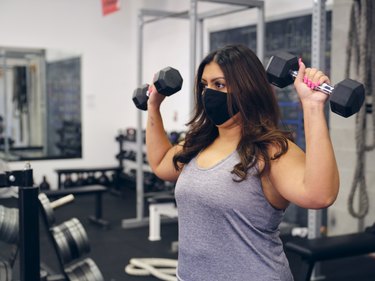


If you're looking to get lean, it makes sense you'd want to focus on doing your favorite cardio exercises, but hitting the weight room is what's ultimately going to help you burn more fat and build muscle.
That's because the weight loss you see from doing cardio and endurance training doesn't just come from fat; it also includes muscle tissue, according to a 2017 study in Advances in Nutrition. And you want to build and maintain muscle tissue because it not only looks good and does good for your body — it's metabolically active. That means it increases your calorie burn even at rest.
Video of the Day
When it comes to resistance training, focusing on compound exercises — movements that recruit multiple muscle groups at once — is going to be the key best part of a lean-body workout routine for men. That because they burn the most calories and build the most lean muscle.
So, in our quest for the best exercises for men to get lean, we asked eight trainers their favorite compound, get-lean exercises. And we got eight awesome answers.
Here are the only eight exercises men need to get lean. For the best results, do each move once or twice per week in your workouts.
Tip
To help you get started with strength training, the American College of Sports Medicine recommends doing 1 to 3 sets of 8 to 12 reps per exercise for beginners or intermediate exercisers. If you're a seasoned lifter, aim to do 3 to 6 sets. No matter your fitness level, you should train all major muscle groups in your body at least once per week.
Move 1: Dumbbell Squat
Dumbbell squats target your quads, glutes, hamstrings and core. Because they work these large muscle groups, they use a lot of energy, which will help you lose fat and build the most lean muscle, says certified personal trainer John Gardner, CPT.
- Stand with your feet about shoulder-width apart and hold a dumbbell in each hand by your sides.
- Push your hips back and bend your knees to lower until your thighs are parallel to the ground (or as low as you can comfortably go). Keep your chest lifted, your back upright and your weight in your heels throughout the movement.
- Press through your heels to stand back up.
Modifications and Variations
If you're not quite ready to move with dumbbells or don't have access to them, do air squats. Place a bench, box, or chair behind you, and bring your butt to tap the chair at the bottom of your squat.
To crank things up a notch, try barbell squats.
Move 2: Barbell Deadlift
A highly functional exercise, the barbell deadlift mimics the same movement pattern you would use to lift something heavy off the ground.
It engages the muscles in your legs, butt and back, which are some of the largest muscle groups in your body, says certified personal trainer TJ Mentus, CPT. Just like the squat, it targets the large muscles in your legs and hips, as well as your back and core, making it useful for burning calories. That's why it's one of Mentus's favorite exercises for shredding fat.
- Stand with your feet shoulder-width apart and place a barbell in front of your shins on the floor. Squat down and grab the bar with your arms outside your legs.
- Hinge your hips back and pull yourself toward the bar. Your shoulders should be above your hips and your hips above your knees. Pack your shoulders down and back to engage your lats.
- Maintaining your posture, slowly pull the bar by pushing into the ground with your feet and legs. Lift until the bar passes your knees, then, press your hips toward the bar and stand up fully.
- Lower the bar down, keeping your spine flat and shoulders packed down.
Modifications and Variations
If you're new to deadlifts, use a kettlebell instead. Kettlebells allow you to activate the same muscle groups with less weight. To perform a kettlebell deadlift, place a kettlebell on the floor between your feet and follow the steps above for the barbell deadlift. Alternatively, you can try the dumbbell deadlift.
As far as progressions go, the barbell is about as heavy as it gets. That said, you can secure one end of a resistance band to the bar, and the other to the ground to add some difficulty at lock-out.
Move 3: Feet-Elevated Push-Up
Leg exercises are great for burning calories, but don't forget about your upper body. Feet-elevated push-ups work well for getting lean because they add another level of intensity to the classic push-up exercise.
By elevating your feet, you put even more strain on your chest, shoulders and triceps, says certified personal trainer Joey Thurman, CPT. Plus, feet-elevated push-ups can be done in the comfort of your home, like on a couch, box or bench.
- Place a box or chair behind you on the floor and get into the push-up position, stacking your shoulders over your wrists and resting your feet on top of the box. Tuck your pelvis in and squeeze your glutes.
- Bracing your core, lower your chest toward the floor until it hovers just an inch above the ground.
- Press your hands into the floor to push yourself back up to the starting position.
Modifications and Variations
If you're not able to hold a solid high plank in this position, place your hands on the floor or top of the box for an incline push-up.
For an added challenge, sling a resistance band across your upper back and hold the ends under your hands. This will make the top of your reps much harder.
Move 4: Lat Pulldown
Your lats — the large muscles that run down the sides of your back — are the biggest muscles in your upper body. Training them helps you get leaner because they require a lot of energy to contract.
Bigger lats also give the appearance of a smaller waist, says Mike Matthews, CPT, author of Muscle for Life. The lat pulldown is a great exercise for men of all fitness levels because you can control the amount of weight on the machine or resistance on a band.
- Set the height of the leg pads so that you can comfortably sit in the machine. Your legs should form 90-degree angles.
- Grab the overhead straight bar attached to the machine and grip it with your hands shoulder-width apart, palms facing away from you
- Bend your elbows and pull the bar into your chest, leaning back very slightly.
- Then, reach up until your elbows are straight to complete the rep.
Modifications and Variations
Bent-over dumbbell rows also target your lats, but don't require a machine. All you need is a set of dumbbells. Start in a bent-over position, similar to the halfway point in a deadlift, with your arms hanging straight down. Next, pull the dumbbells in toward your stomach then lower them back down.
To up the challenge, conquer the pull-up.
Move 5: Kettlebell Swing
The kettlebell swing is one of the most dynamic strength exercises you can do; it's great for getting your heart rate up while targeting your hips, glutes and core. In fact, the top of your swing should feel like a plank, bracing your core and squeezing your glutes.
Strength coach and certified kettlebell instructor Dan Leary likes the kettlebell swing because it's comparable to sprinting in terms of the number of calories burned.
- Stand with your feet shoulder-width apart with a kettlebell a few inches in front of you, so you form a triangle with the kettlebell and your feet on the ground.
- Hinge your hips back and hold the kettlebell with both hands using a loose grip.
- Pushing your butt back and keeping your back flat, hike the kettlebell between your legs.
- As you straighten your legs to stand, use power from your hips to pull the kettlebell up to chest height.
- Using the bell's momentum, swing the weight back between your legs and under your hips as you simultaneously sink into your hips and bend your knees.
Modifications and Variations
Before you take on the KB swing, master the hip hinge (aka deadlift).
Once the swing starts to feel easy, you can try one-arm variations.
Move 6: Dumbbell Squat to Overhead Press
Two moves are always harder than one, and that's exactly what makes this combo exercise great for weight loss. You're not only activating muscles in your legs and hips, but also in your shoulders and arms — again, large muscle groups.
Plus, to hold the weight on your shoulders, your core muscles have to work really hard to stabilize you, says certified strength and conditioning specialist Kyle Gonzalez, CSCS.
- Stand with your feet shoulder-width apart and hold a dumbbell in each hand by your shoulders so that one end of the weight is resting on top of your shoulders.
- Keeping your chest lifted and your weight in your heels, push your hips back and bend your knees, lowering until your thighs are parallel to the ground (or as low as you can comfortably go).
- Press your heels into the ground to stand back up. At the same time, press the dumbbells overhead, finishing with your biceps by your ears.
- Lower the weights back down to your shoulders and repeat.
Modifications and Variations
You can do this exercise with a barbell or kettlebell, Gonzalez says. The same technique applies, but the equipment you use is interchangeable.
Move 7: Dumbbell Split Squat
In single-leg exercises like the split squat, one leg is doing more work than the other — typically the leg in front. There's also less stability than in a classic squat because it's harder to balance in a split stance.
Certified personal trainer Mendy Borevitz, CPT, uses the split squat to help his clients get lean because it requires extra energy to balance and therefore, burns more calories. It also calls builds unilateral muscular strength, making your legs stronger for athletic movements such as running.
- Hold a dumbbell in each hand by your sides. Stand in a split stance with one leg forward and one leg back. Place a soft pad between your feet.
- Keeping your torso upright, bend your knees until your back knee touches the pad and your front leg forms a 90-degree angle. Keep your back heel off the ground throughout the movement and make sure that your back hip is stacked over your back knee.
- Use your legs to stand back up, maintaining an upright torso. At the top, keep your feet in place and repeat until you've completed all reps, then switch legs.
Modifications and Variations
An assisted split squat will help you master the movement before adding weight, Borevitz says. One of his favorite variations is a TRX split squat, which uses the TRX straps for support.
Start in the split stance with one foot forward and the other back. Grab a TRX handle in each hand and descend into the split squat. Gently pull on the handles to ease yourself down, then pull gently to help yourself back up.
For an added challenge, do a Bulgarian split squat by placing your back foot on top of a box or bench
Move 8: Farmer's Carry
The farmer's carry is a simple move in terms of technique, but it works many muscles. Jake Dickson, CPT, a certified personal trainer and weightlifting coach, uses this exercise to help his clients get lean because it's a mix of strength and cardio.
When done properly, it takes longer to complete this exercise than most strength-training exercises because you move more slowly. The added time takes a toll on your cardiovascular system and burns calories. The farmer's carry also strengthens your grip, glutes, core, shoulders, arms, traps and calves.
- Place a pair of kettlebells or dumbbells on the ground next to your feet. Stand with your feet hip-width apart.
- Safely pick up the weight by squatting down with a flat back, gripping the weights by their horns and standing up using your legs.
- Holding the weights at your sides, slowly walk forward, maintaining an upright posture, for 30 seconds.
- Put the weights down by bending your legs and maintaining a flat back.
Modifications and Variations
If the farmer's carry feels too strenuous, you can start with a suitcase carry. Instead of holding a weight in each hand you'll hold a weight in one hand by your side. Choose a light weight and focus on keeping an upright posture as you walk, slowly and with control, in a straight line.
To work even more muscles at once, try the offset waiter's carry.


